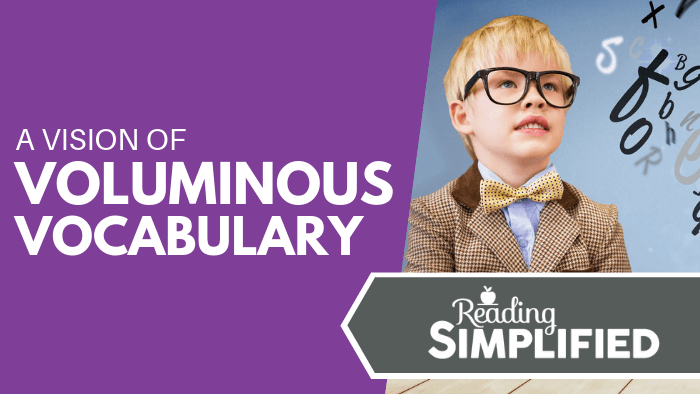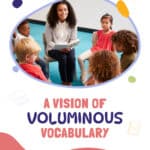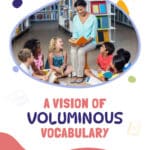
Did you know that--after students become fluent in recognizing words--the main difference between a good reader and a poor reader is almost always their vocabulary knowledge?
Teaching our kids to recognize how to read words is only the first hurdle. The next step is to get them to learn the meanings of hundreds, no thousands of words, so they have voluminous vocabulary knowledge.
The problem is that there are thousands of words our kids need to know, and we only have them for 180 days of the year!
In this post, I reveal how you can impart voluminous vocabulary to your students to help ensure they become strong readers who are both college and career ready.
{To watch the video where I discuss this topic, hit play below or read on for a detailed overview}
Why is voluminous vocabulary so important?
Here’s a quick quiz for you…how many words do you think students need to learn per day to become college and career ready by the time they finish 12th grade?
The exact number is hard to pin down. However, researchers have come up with a ballpark figure that reveals that by the end of 12th grade, kids need to know 50,000 word families. If we define this number even further, we can assume our kids have to learn approximately 3,000 to 4,000 words per year, which is around 16 to 20 words a day. :O
I know what you’re thinking…how on earth can you teach students up to 20 words a day? It sounds impossible, and it can’t all come from your explicit teaching in the classroom alone.
However, there are ways that you can prepare your students to learn around 4,000 words a year – and I’m going to show you how!

How to teach 4,000 words a year
On average, one needs to read around 1,000 words to learn just one new word. That sounds like a mammoth challenge, especially for kids who would rather play the PlayStation than read a good book!
So, how can you teach 4,000 words a year?
It's probably self-evident that one can't explicitly teach that many words each year. Instead, most of these words must be learned through wide reading, which we wrote about in recent blog posts like this one and this one. However, we can still make a big impact in our students' word learning through explicit instruction.
Here are some key principles I want you to consider for building a voluminous vocabulary in all your students:
1. Define and elaborate all day
You’re probably already defining and elaborating words all day long, and it’s definitely one of the best strategies to help increase your students’ exposure to new words.
But here's a reminder about the importance of this all-day-work. Don't be afraid of using sophisticated words...just define them as needed. So, whether you’re discussing a new concept in science or simply commenting on the weather, throw out some big words and elaborate on them.
If you can do this, you’ll help pass along rich vocabulary to your students via oral language.
2. Cultivate word consciousness
You can also teach kids to become more aware of their words and the words that they don’t know by cultivating word consciousness in fun and investigative ways.
It’s time to put on your creative caps for this one! There’s an infinite number of ways to make this as interesting as possible for your students.
For example, if they’re reading a novel and come across a word they don’t recognize, ask them to write it down on a sticky note attached to the inside book cover. As they read the whole book, they can form a list of words they can investigate the meanings of later.
This game of exploration is a great way to get kids excited about learning new words and helps raise their word consciousness.
3. Plan–fully teach and review specific words
Instead of embedding your vocabulary instruction throughout the day haphazardly, you want to implement a strategic approach so that students obtain the best possible value from the lesson.
You can do this by choosing specific high frequency words from read alouds or content areas and reviewing them in detail with the rest of the classroom.
But I know it's also hard to know what words to select, right?
I have 2 ways to think about which words to teach...
1) Dr. Isabel Beck has developed the concept of teaching Tier 2 words--those words that aren't simple every day words (Tier 1) like "run" or "banana," and aren't so esoteric and niched, like "esoteric" and "isotope." Instead, Tier 2 words are high frequency words that mature readers and speakers are more likely to use. Thus, they are the words our students need to know!
Dr. Beck has a brief exercise here to help you play around with this concept of Tier 2 words.
2) Another approach to consider is to examine lists of high-frequency words to get a better sense of the most important words your students may need to know.
What types of words are in this level? What words would likely be beyond this level?
For example, reading researcher Dr. Elfrieda Hiebert who developed the fabulous site TextProject.org, provides a list of the 4,000 most frequent word families here. This list makes up 90% of written material. That's a BIG deal! When our students know these words, they will be much more likely to be able to comprehend most texts they encounter.
So, either by using a set vocabulary curriculum and/or by selecting a set of words yourself, explicitly teach some words every day. Collect them. Review them. Play games with them.
4. Teach word-learning strategies (using context and learning roots)
You can increase the number of words your students have the potential to learn daily by coaching word-learning strategies. For example, those readers at the 4th grade reading level and up are probably primed to learn Greek and Latin roots, such as "graph" or "logos." If they know that "graph" means "to write," it will make it easier for them to deduce the meanings of words such as:
graphic
biography
autobiography
telegraph
demographic
choreograph
photograph
calligraphy
epigraph
bibliography
paragraph
geography
Head to this YouTube station if you'd like your students to learn new roots such as "graph" every day through 5 minute videos. Sweet!
In addition, you can coach your students on how to deduce word meanings, where possible, from context. Place a text on the screen or SmartBoard and read it aloud. When you come across a challenging word, challenge your students to explain what the word might mean from the clues in the text alone.
Sometimes using context works; sometimes it doesn't! So be sure to share that insight with your students.
And be sure that some of your example words are defined like an appositive--where a word is defined right beside it. Appositives are often set apart by commas or dashes. For instance,
Marge explained everything in hyperbolic, or exaggerated, terms.
In this example, "or exaggerated" is the appositive phrase that is intended to define the meaning of "hyperbolic."

5. Connect words in all content areas through thematic learning
It’s important to connect the words in various content areas with a thematic approach. For example, if you’re studying American history, you can focus on words commonly used in that time period. This helps to build a mental web of vocabulary that’s connected to the specific theme or concept.
6. Individualize word collections
One of the best ways to impart a rich vocabulary to our kids is to make the experience personal to them. You can do this by encouraging them to create individualized word collections on a particular topic, or from a particular book, that they are interested in. With this strategy, each child has perfectly individualized list of words s/he is working on learning.
Differentiation mastery!
Each child might have a small journal where she collects words she heard spoken or read in a book. (One can use a similar practice for collecting spelling words, so each child zeros in better on words s/he actually needs to learn.)
A vocabulary word wall is an excellent way to get kids excited about learning new words and regularly referring back to them.
Implement a daily system
If you really want to teach your students up to 4,000 words per year, I suggest implementing a daily system that you can refer back to when you’re trying to teach a bunch of new words in a limited timeframe.
With so many words to learn, it’s easy for kids to become disinterested, bored or confused. If you really want to bestow your kids with voluminous vocabulary, there are certain routines you can do to help achieve this goal.
I’ve come up with a daily system for teaching tons of words to help establish a rich vocabulary. It involves a few steps that are designed to increase kid’s exposure to words while assisting them to actually to learn and remember what they’ve learned. This is achieved through reinforcement of the word both verbally and the physical act of writing.

Research has shown that handwriting connects with memory faster than anything else, but there’s also other forms of vocabulary instruction. If a few of your kiddos enjoy a bit of drama, why not encourage them to define the word and then act it out in context?
This is a fun and engaging way to get kids thinking about the definition of the word and then coming up with a way to bring that word to life like a fun game of Pictionary.
If you want a succinct vocabulary-learning routine, leave your name and email address below to receive your FREE “Vision for a Voluminous Vocabulary” bookmark!
Finally, what routines and resources do YOU use to impart a strong vocabulary to your students? Please share in the comments below. 🙂




I have learned a lot for your insruction. I wonder if you could share it with me.
We show teachers and parents how just a small handful of activities can rapidly accelerate all beginning and struggling readers’ decoding. You can learn more about our core techniques in 1 of two ways: 1) You can read about these core activities on our blog here: ReadingSimplified.com/start-here OR, 2) You can watch an on-demand workshop, 3 Activities a Day to Keep Reading Difficulties Away, when it’s convenient for you. Register for a time for this workshop here: ReadingSimplified.com/webinar